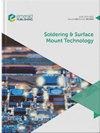基于表面能的倒装芯片底部填充过程填充时间分析模型
IF 1.8
4区 材料科学
Q3 ENGINEERING, ELECTRICAL & ELECTRONIC
引用次数: 0
摘要
目的建立基于碰撞后流表面能的倒装充填过程充填时间预测分析模型。设计/方法/方法当前模型是基于改进的区域分离方法制定的,该方法由凹凸区域和凹凸后区域组成。考虑表面能量-功平衡,将膨胀流和随后的无碰撞流整合到碰撞后区域进行建模。结果表明:通过以往的下填试验验证,与以往的6种分析模型相比,当前模型的均方根偏差最小,为4.94 s,个体偏差最大,为26.07%。此外,目前的分析预测的碰撞后区域的流动等值线与实验观测相符。此外,与之前的模型相比,当前碰撞后区域的分析填充时间与实验时间的一致性更好。因此,该模型被认为是过去填充时间模型的临时版本。实际意义所提出的分析模型能够以更高的精度确定倒装芯片下填过程的填充时间,同时提供更精确和真实的凹凸后流动可视化。该模型可为今后的灌装工艺改进和包装设计优化工作提供参考,解决灌装时间过长的生产效率问题。原创性/价值分析下填料研究很少,迄今为止仅开发了七个独立的分析填充时间模型。特别是在之前的两篇论文中,对脱离跳跃的膨胀流进行了研究。尽管如此,据笔者所知,目前还没有一个分析模型考虑了下填土流动过程中的地表能或基于其能量功平衡。相反,之前对碰撞后流的建模是基于运动学或几何的,并与主要假设相结合。本文章由计算机程序翻译,如有差异,请以英文原文为准。
Surface energetic-based analytical filling time model for flip-chip underfill process
Purpose
This paper aims to present new analytical model for the filling times prediction in flip-chip underfill encapsulation process that is based on the surface energetic for post-bump flow.
Design/methodology/approach
The current model was formulated based on the modified regional segregation approach that consists of bump and post-bump regions. Both the expansion flow and the subsequent bumpless flow as integrated in the post-bump region were modelled considering the surface energy–work balance.
Findings
Upon validated with the past underfill experiment, the current model has the lowest root mean square deviation of 4.94 s and maximum individual deviation of 26.07%, upon compared to the six other past analytical models. Additionally, the current analytically predicted flow isolines at post-bump region are in line with the experimental observation. Furthermore, the current analytical filling times in post-bump region are in better consensus with the experimental times as compared to the previous model. Therefore, this model is regarded as an improvised version of the past filling time models.
Practical implications
The proposed analytical model enables the filling time determination for flip-chip underfill process at higher accuracy, while providing more precise and realistic post-bump flow visualization. This model could benefit the future underfill process enhancement and package design optimization works, to resolve the productivity issue of prolonged filling process.
Originality/value
The analytical underfill studies are scarce, with only seven independent analytical filling time models being developed to date. In particular, the expansion flow of detachment jump was being considered in only two previous works. Nonetheless, to the best of the authors’ knowledge, there is no analytical model that considered the surface energies during the underfill flow or based on its energy–work balance. Instead, the previous modelling on post-bump flow was based on either kinematic or geometrical that is coupled with major assumptions.
求助全文
通过发布文献求助,成功后即可免费获取论文全文。
去求助
来源期刊

Soldering & Surface Mount Technology
工程技术-材料科学:综合
CiteScore
4.10
自引率
15.00%
发文量
30
审稿时长
>12 weeks
期刊介绍:
Soldering & Surface Mount Technology seeks to make an important contribution to the advancement of research and application within the technical body of knowledge and expertise in this vital area. Soldering & Surface Mount Technology compliments its sister publications; Circuit World and Microelectronics International.
The journal covers all aspects of SMT from alloys, pastes and fluxes, to reliability and environmental effects, and is currently providing an important dissemination route for new knowledge on lead-free solders and processes. The journal comprises a multidisciplinary study of the key materials and technologies used to assemble state of the art functional electronic devices. The key focus is on assembling devices and interconnecting components via soldering, whilst also embracing a broad range of related approaches.
 求助内容:
求助内容: 应助结果提醒方式:
应助结果提醒方式:


